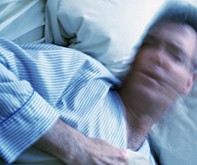Peer Reviewed
Feature Article Psychiatry and psychology
REM sleep behaviour disorder and its link with neurodegenerative diseases
Abstract
A diagnosis of REM sleep behaviour disorder has important prognostic implications. The disorder is associated with synuclein-depositing neurodegenerative diseases and can be a harbinger of future decline and disability in those with these diseases.
Key Points
- The hallmark of REM sleep behaviour disorder (RBD) is the loss of the atonia that characterises REM sleep and which permits patients to act out dreams, often resulting in injury.
- Typically affecting older men, RBD is primarily diagnosed by history. Polysomnography is important in both confirming the diagnosis and ruling out differentials.
- Both nonpharmacological and pharmacological measures should be considered in patients with RBD.
- RBD confers a greater risk of Parkinson’s disease, multiple-system atrophy and dementia with Lewy bodies, and in patients with these conditions, it confers a worse prognosis and more rapid progression of neurocognitive symptoms.
- Prompt referral and diagnosis of patients with suspected RBD is therefore important in most cases.
Purchase the PDF version of this article
Already a subscriber? Login here.

